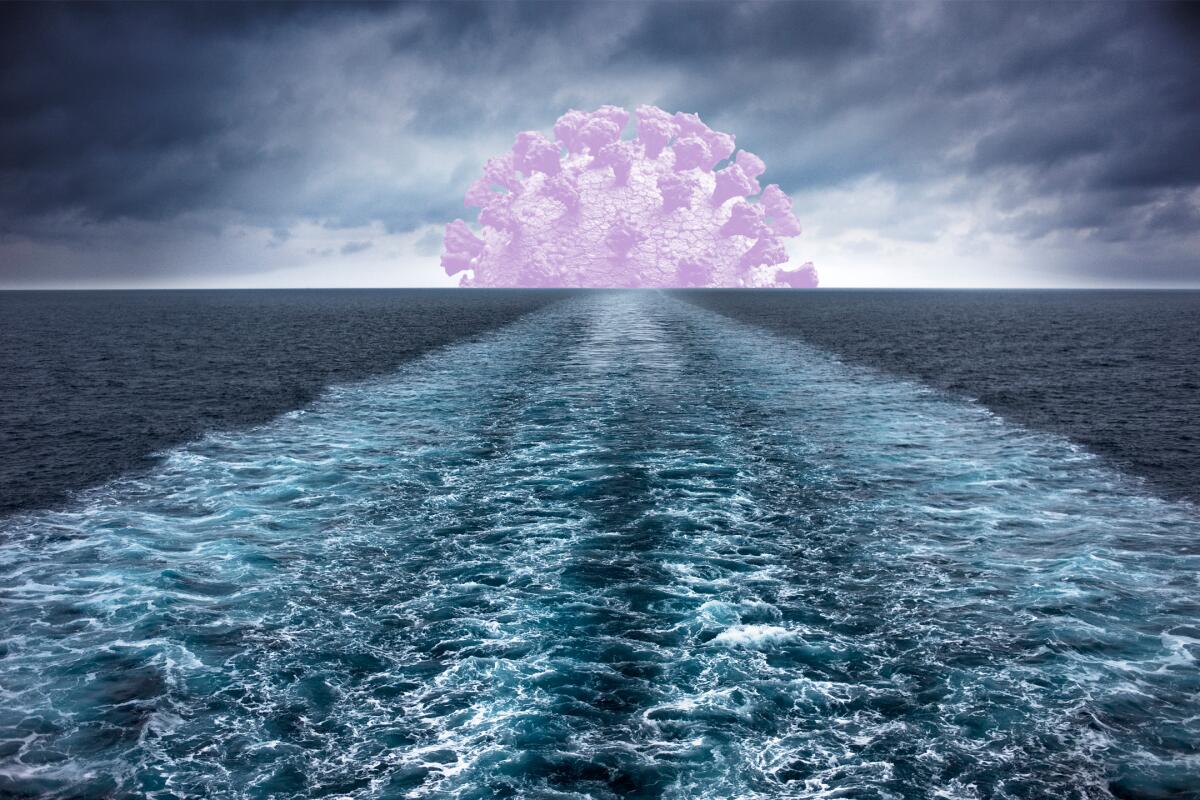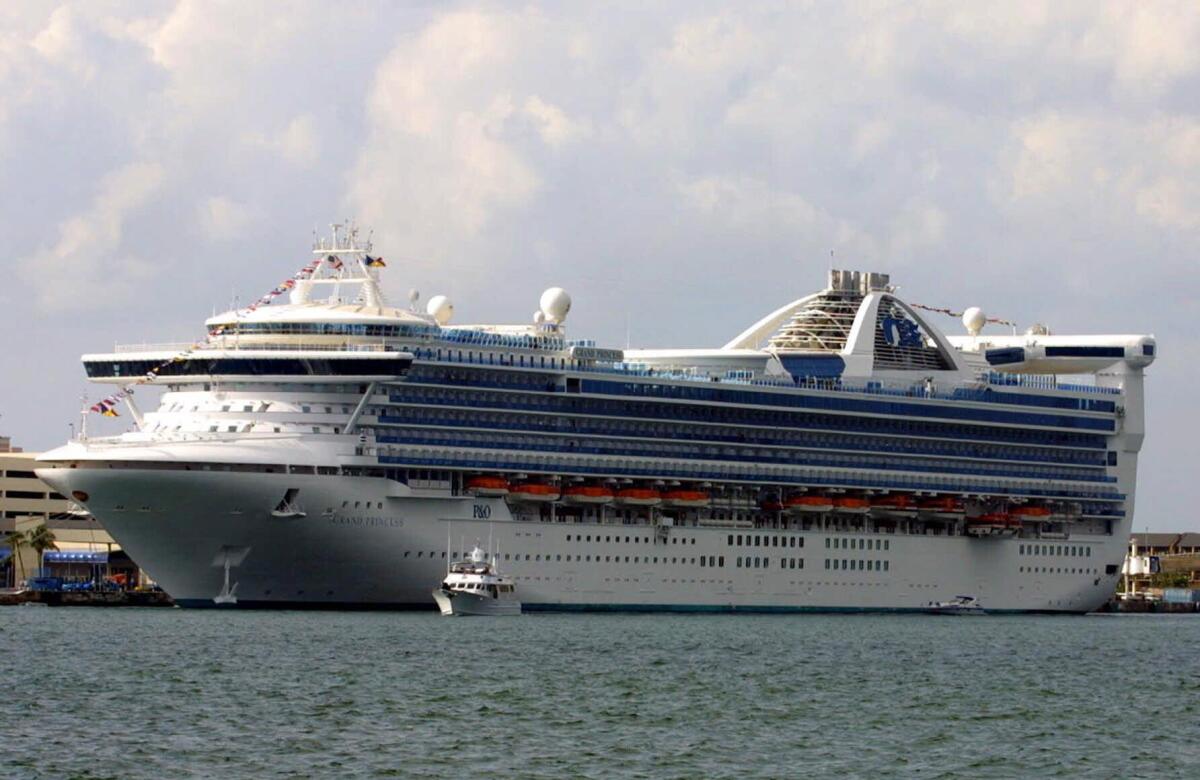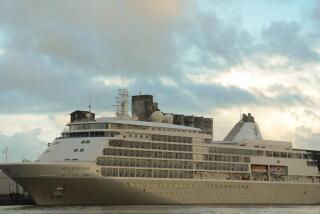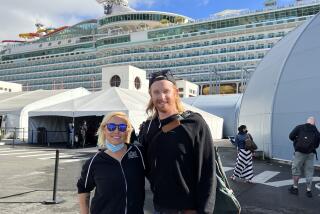To cruise or not to cruise. Loyalists face a dilemma

)
- Share via
The cruise industry has been in free fall since the COVID-19 pandemic struck in March. Not only are vessels unable to sail, but the swirl of bad publicity has also left the public believing that cruise ships are deadly incubators of disease.
Will travelers ever want to sail again? Cruise junkies say yes; experts say it might take a long time for the industry to recover.
Carol and Dennis Bingham are fans with an unusual perspective. They lived through a highly publicized coronavirus voyage; nevertheless, they can’t wait to go again.
The Las Vegas couple would be looking forward to their next trip, a 28-day South Pacific holiday in October. But the voyage, like thousands of others, was scratched because of no-sail orders from both the cruise industry and the Centers for Disease Control and Prevention that suspended passenger operations.
The Binghams are veterans of 54 cruises, including an ill-fated Grand Princess journey in February that began as a 15-night Hawaiian cruise and turned into a waking nightmare for the more than 3,500 passengers and crew when the coronavirus was discovered onboard.
The ship was forced to sail in circles off San Francisco because port officials wouldn’t allow it to dock. President Trump didn’t help matters when he said he preferred passengers stay onboard rather than add to the coronavirus case total in the U.S.
The ship finally was allowed to dock in Oakland and its passengers quarantined. The Binghams were transported to Marine Corps Air Station Miramar in San Diego, where they spent two weeks before being allowed to go home.
“It was an ordeal,” Carol Bingham said. “But the Princess [Cruises] people were wonderful. It wasn’t their fault it happened.” And, she added, “We really love cruising.
“But next time there needs to be a vaccine and everything has to be safe.”
The Binghams are part of an estimated 20% of cruisers who are true loyalists. Christopher Muller, an industry consultant and retired professor of hospitality at Boston University, calls it the 80-20 rule. He said the cruise industry has a lot of occasional business — people who sail once in a while — and 20% that could be classified as regulars. The regulars can be depended upon to return to cruising as soon as they can.

“But a lot of the regulars are older and see themselves at risk for COVID-19,” he said.
It doesn’t help that 3,000 likely cases of the disease and 34 deaths have been linked to the cruise industry, according to a July report by the CDC.
Cruising has always fueled fear of illness in some people who worry about seasickness, among other things.
At one time, said Muller, the cruise industry treated onboard diseases as if they didn’t exist. “They just pretended it didn’t happen. Then in 2013, to their credit, they got smart and at first indication of a disease like norovirus, they’d pull up at the nearest harbor, get everybody off and do a deep clean.” (Norovirus, a contagious virus, causes vomiting and diarrhea.)
But the ships infected with the coronavirus earlier this year were not allowed to dock; they were forced to sail aimlessly as they sought an open port that would accept them. Meanwhile, the disease spread onboard. “That was the worst thing that could have happened,” Muller said.
Five months later the contamination problem remains. No matter how thoroughly ships are cleaned, new passengers can bring the disease onboard, he said. Two international sailings earlier this summer — in the South Pacific and in Scandinavia — had to be discontinued when passengers or crew members tested positive for the virus.
Other issues further complicate problems for the industry: Cruise ships often have small cabins, many without balconies and fresh air. They also have common dining areas, common entertainment areas and common transportation to onshore highlights. “How do you separate passengers so they’re socially distanced?” Muller said.
“It’s frightening. Everyone would be afraid of the people in the next cabin.”
Still, some fans are ready to sail again. Cruise companies and travel agency networks say bookings for 2021 are rising. Some can be attributed to cancellations this year, but the majority are for new bookings.
“We’re seeing some incredibly positive feedback from cruisers, most who say they will book a cruise again,” said Colleen McDaniel, editor in chief of Cruise Critic, an online service that rates ships and itineraries.
Recent surveys by the organization show that “those who have sailed most frequently are more likely to respond that they’ll book a cruise. They’re passionate about cruising and have a longstanding confidence in the cruise lines,” she said.
But they won’t be embarking soon. A handful of ships are sailing in Europe, but Americans aren’t allowed to enter the European Union for leisure travel.
In the U.S., the CDC has placed a no-sail order on cruise ships through Sept. 30; the industry itself has canceled U.S. cruises until at least Oct. 31. Some lines don’t plan to get underway again until 2021.
In the meantime, cruise companies are consulting with scientists and setting up safety protocols, including the use of scanners at terminals to check for elevated temperatures, disinfection foggers to clean ships, upgraded ventilation systems, and the elimination of group activities and self-serve buffets.
Infectious disease expert Andrew Noymer speculates that they will also slash prices. “They’ll do that to bring out the risk-takers,” said Noymer, an associate professor of public health at UC Irvine who specializes in mortality and disease prevention.
“There will still be ample transmission possibilities onboard,” he added. “I would recommend people not do it. The advice columnist in me says, ‘Don’t go.’”
Some travelers may avoid sailing because they don’t want to have to wear masks and practice social distancing.
“I’m eager to cruise again, but I don’t want to go if it seems like I’m going on a hospital ship,” said cruise veteran Elizabeth Harryman, recently retired travel editor of Westways magazine. “I’ll wait until I can dance and have fun and not have to worry about coronavirus.”
More to Read
Sign up for The Wild
We’ll help you find the best places to hike, bike and run, as well as the perfect silent spots for meditation and yoga.
You may occasionally receive promotional content from the Los Angeles Times.






